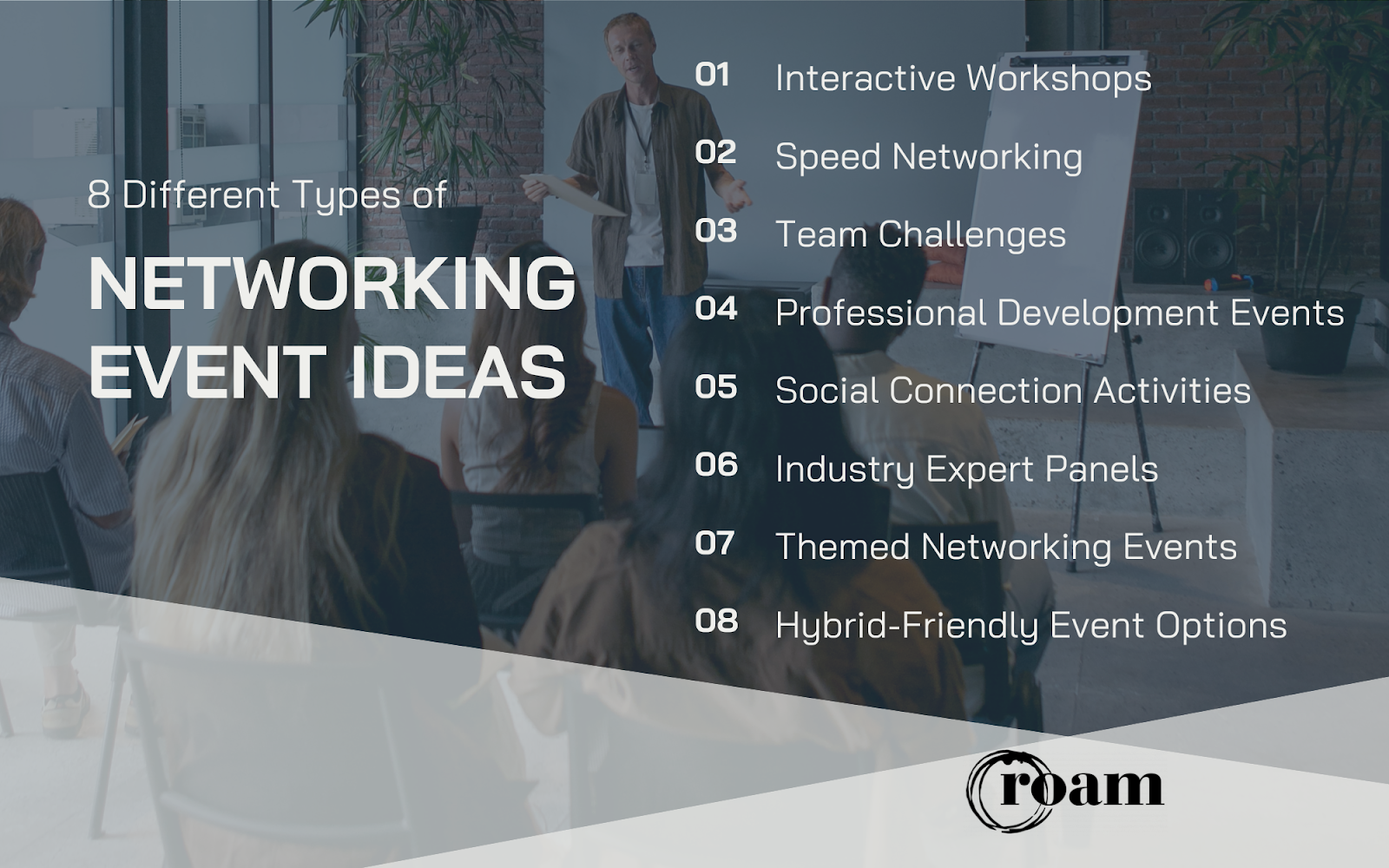8 Different Types of Networking Event Ideas For Your Team
Short Answer: Meaningful connections drive business success. Studies show that over half of professionals prefer networking formats that connect them with new people and peers facing similar challenges.
Why Networking Matters
Team cohesion doesn’t happen by accident. The right networking event can transform your department’s communication, spark innovation, and build the relationships that power your business forward. Here are some ideas for your next networking event.

1. Interactive Workshops
Skill-Share Sessions
Have team members teach mini-workshops on their specialties. For example, the marketing expert shares social media tricks while the finance guru explains budget basics. When people learn together, they naturally form connections that last. These knowledge exchanges build respect between departments and the cross-training can further the careers of participants.
Expert-Led Learning Sessions
Bring in various industry leaders for hands-on training or panel discussions. These expert-led trainings are perfect for introducing new skills or technologies to multiple teams simultaneously.
Collaborative Problem-Solving Initiatives
Present real business challenges and form cross-departmental teams to develop solutions. Nothing builds relationships faster than tackling meaningful problems together, and the shared accomplishments create lasting bonds between team members. Plus, you can get business initiatives and problems addressed by your team members.
2. Speed Networking With Purpose
Focused Topic Rotations
Similar to speed dating, set up rotations for one-on-one discussions. This can be employees of the same level interacting with each other or set up as ‘speed mentoring’ for leaders and executives to talk to junior employees. Structure each round around specific discussion or icebreaker questions. For example, “what’s your biggest challenge this quarter?” creates a more meaningful dialogue and creates a transparent line of communication. Keep rotations brief (3-5 minutes) and energetic for the maximum effect.
Interest-Based Matching
Divide attendees into groups with complementary skills or challenges so employees can meet similar people across departments and teams. Create deliberate cross-pollination between departments that don’t typically interact to generate fresh perspectives and build organizational awareness.
3. Team Challenges
Business Scavenger Hunts
Organize challenges or games that require collaboration between team members. Mixing teams across departments and seniority levels helps break down organizational barriers and creates connections that might not happen organically in the workplace.
Hackathon-Style Events
Give teams 24 hours to develop solutions to real business challenges facing your organization. The time pressure and creative freedom often lead to breakthrough thinking. Present results and award prizes at the end to recognize innovation. Celebrate creative ideas regardless of implementation feasibility – the goal is connection and idea generation, not just practical outcomes.
Immersive Problem-Solving Challenges
Immersive challenges like escape rooms or murder mystery parties reveal how people think and collaborate under pressure, highlighting natural leaders and creative thinkers within your teams. These event types are typically available in both physical venues and virtual formats for remote teams. These shared experiences can become natural conversation topics for follow-up networking long after the event ends.
4. Professional Development Events
Leadership Summit
Create an event that mixes formal presentations and learning with structured networking activities designed specifically for relationship building. Help connect up-and-coming leaders with executives in low-pressure settings. Focus on relationship-building as much as content delivery, recognizing that the connections formed often prove more valuable than the information shared.
Tech Demo Day
Organize an event showcasing new tools and technologies with hands-on demonstration stations. This creates natural opportunities for IT and technical teams to connect with other departments. Include dedicated time for questions, exploration, and one-on-one consultations to foster meaningful relationships centered around innovation.
Skills Exchange Fair
Design a marketplace atmosphere where team members can “shop” for expertise and offer their specialized knowledge. Include professional development elements like headshot stations and profile optimization for internal systems or LinkedIn.
5. Social Connection Activities
Culinary Connections
Food-centered events like cooking challenges or tasting experiences naturally break down barriers between colleagues. Remember to consider dietary restrictions and preferences for inclusivity, allowing for active participation in the shared experience.
Creative Workshops
Art-based activities effectively reduce workplace hierarchy and encourage authentic conversations about topics beyond daily work. Options include painting classes, photography workshops, or craft projects that engage different skills than most workplace tasks.
Exercise or Sports Activities
Movement-based networking alternatives like walking meetings energize conversations and often lead to more candid exchanges. If you have an all day event or a retreat, consider a morning yoga session to set a collaborative tone. For a more active team, consider capture the flag or other team games. Friendly competition builds camaraderie through teamwork and shared achievement, creating bonds that transfer back to workplace collaboration.
6. Industry Expert Panels
Roundtable Discussions
Organize smaller groups that rotate between different guest speakers throughout your event. These discussions can focus on practical application of insights rather than theoretical concepts. Include dedicated networking time after each session for participants to connect with others who share similar interests or challenges identified during the expert discussions.
Fireside Chats
Schedule informal conversations with thought leaders in a comfortable setting that encourages authentic conversation. So there isn’t a lapse in discussion, prepare some topics and questions. Also, encourage Q&A throughout the chat.
Expert Office Hours
Arrange one-on-one or small group time with specialists who can address specific challenges facing your teams. These collaborative opportunities allow peers with similar challenges can work together with the expert, forming connections that continue after the formal consultation ends.
7. Themed Networking Events
Industry Trend Education
Design specific meetings centered around emerging developments in your field for preparation and innovation. By pre-distributing articles or research, you can ensure informed discussion between your team.
Business Challenge Stations
Set up themed tables focusing on specific business challenges your organization faces. In small groups, these teams can identify solutions to these problems and write them down. At the end of the event, the executive team can implement ideas that have merit. This can show that your team values participants’ involvement and allows your team to come together to better the company.
Future Vision Workshops
Facilitate collaborative forecasting activities that encourage big-picture thinking while building relationships. Form teams to imagine future scenarios relevant to your business. These forward-looking discussions build relationships anchored in shared vision rather than just current projects, creating connections with long-term organizational value and commitment to the company in the long term.
8. Hybrid-Friendly Event Options
Digital Attendance Opportunities
Set up dedicated screens for virtual event attendees to participate fully in predominantly in-person events and workshops. Engage the in-person and remote attendees equally in discussions and activities to further involvement and team building.
Asynchronous Events and Education
With a virtual networking event, it’s possible to connect your global team. Structure events across time zones with asynchronous elements to include as many team members as possible. Consider a follow-the-sun format for 24-hour engagement that makes global team members feel valued and included in the organization’s relationship-building efforts.
Virtual Breakout Room Discussions
Almost all in-person conversations and events can be facilitated over virtual platforms. Using break-out rooms, you can ensure online participants can have small-group experiences that mirror the intimacy of in-person networking conversations. If some of the team is in person, mix virtual and in-person attendees in digital rooms to prevent the formation of “location silos” that can undermine the team collaboration.

Tips to Remember for Event Organizers
Use Digital Connection Tools
There are simple apps for exchanging contact information and meeting notes in order to connect your employees more easily. This can eliminate the ‘business card shuffle’. These tools not only help employees exchange information during the event, but make it easy for them to follow up with each other as well.
Host Follow-Up Events and Connection Opportunities
Extend the impact of your main networking event by planning follow-up conversations. This can be anything from a reception following the main event to structured follow-up sessions in the following weeks on specific topics from the event. These intentional follow-up strategies prevent “event amnesia” and transform one-time networking experiences into lasting organizational value.
What Makes the Perfect Networking Event Environment?
Conversation Zones
- Various seating arrangements – from lounge areas to high-top tables
- Quiet corners for a more relaxed atmosphere and deeper discussions
- Open spaces for large group interactions
Activity Areas
- Demonstration spaces for product showcases
- Interactive displays that serve as conversation starters
- Tech-enabled areas for presentations or collaborative work
Practical Considerations
- Good lighting and clear pathways between activities
- Reliable WiFi and accessible power outlets
- Comfortable temperature and appropriate noise levels
Making It Happen at Roam
Planning a successful networking event comes down to purpose, people, and place. At Roam, we’ve designed our meeting spaces specifically for these connection-focused events:
- Flexible layouts that adapt to any networking format
- Built-in technology for seamless presentations and hybrid connections
- Dedicated hospitality teams so you can focus on relationship-building
- Coffee bars and custom catering to keep energy high
- Multiple breakout spaces for simultaneous small-group activities
Ready to plan your team’s next connection opportunity? Explore our office and meeting room options to fine the perfect environment for your networking goals.
